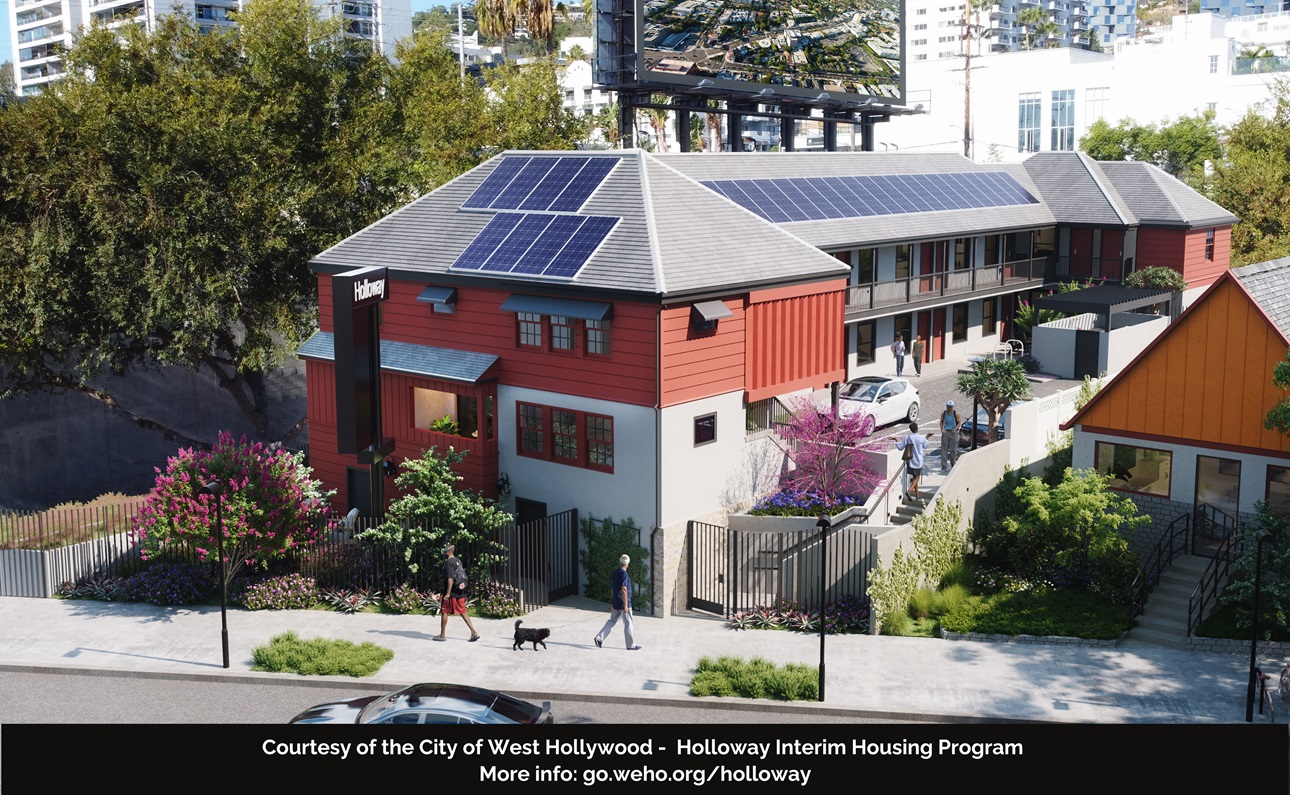- English
- 中文 (Chinese)
- Français (French)
- Deutsch (German)
- 日本語 (Japanese)
- Español (Spanish)
Estudio de caso de ULI para personas sin hogar a vivienda: Programa de vivienda provisional de Holloway

Vivienda de apoyo provisional en West Hollywood, California
El Programa de Vivienda Provisional de Holloway en West Hollywood, California, es un proyecto transformador que reutiliza el antiguo Holloway Motel en una instalación de vivienda de apoyo provisional de 20 habitaciones para personas sin hogar. Es un componente central del Plan Quinquenal de la Ciudad de West Hollywood para abordar la falta de vivienda y se espera que abra en el verano de 2025. Los residentes podrán permanecer de 30 a 90 días mientras reciben servicios integrales destinados a ayudarlos a hacer la transición a una vivienda permanente.
El proyecto se inició a través de un fuerte apoyo de la comunidad y está financiado principalmente por el Programa Homekey de California, que proporcionó una subvención de $6 millones. La ciudad de West Hollywood complementó estos fondos con reservas de su Fondo Fiduciario de Vivienda Asequible y negoció un acuerdo de desarrollo que permite al propietario anterior retener los derechos de ingresos de las vallas publicitarias, un factor esencial para facilitar la venta. La ciudad también se beneficiará de una parte de estos ingresos para apoyar las operaciones del programa.
La instalación será operada por Ascencia, una organización sin fines de lucro que brinda servicios de vivienda y apoyo. Los residentes serán referidos por proveedores locales de servicios para personas sin hogar y deben cumplir con la definición federal de falta de vivienda crónica. Los servicios incluyen atención médica, preparación para el empleo y planificación financiera, todos proporcionados en un entorno informado sobre el trauma y la vivienda primero.
El proyecto enfrentó desafíos, incluida la necesidad de remediación ambiental, retrasos en la construcción, problemas de coordinación de servicios públicos e incendios forestales a principios de 2025. Sin embargo, la colaboración estratégica entre la Ciudad, Ascencia y los equipos de diseño / construcción aseguró un progreso continuo.
Una vez completado, el Programa Holloway duplicará la capacidad de vivienda provisional de West Hollywood, ejemplificando cómo la reutilización adaptativa, la financiación estatal y las asociaciones público-privadas pueden abordar la inseguridad de la vivienda. También sirve como un modelo replicable para otras ciudades que buscan soluciones innovadoras e impulsadas por la comunidad para la falta de vivienda.
Resumen del estudio de caso: El Programa de Vivienda Provisional de Holloway en West Hollywood, California, es un proyecto transformador que reutiliza el antiguo Holloway Motel en una instalación de vivienda de apoyo provisional de 20 habitaciones para personas sin hogar. Es un componente central del Plan Quinquenal de la Ciudad de West Hollywood para abordar la falta de vivienda y se espera que abra en el verano de 2025. Los residentes podrán permanecer de 30 a 90 días mientras reciben servicios integrales destinados a ayudarlos a hacer la transición a una vivienda permanente.
El proyecto se inició a través de un fuerte apoyo de la comunidad y está financiado principalmente por el Programa Homekey de California, que proporcionó una subvención de $6 millones. La ciudad de West Hollywood complementó estos fondos con reservas de su Fondo Fiduciario de Vivienda Asequible y negoció un acuerdo de desarrollo que permite al propietario anterior retener los derechos de ingresos de las vallas publicitarias, un factor esencial para facilitar la venta. La ciudad también se beneficiará de una parte de estos ingresos para apoyar las operaciones del programa.
La instalación será operada por Ascencia, una organización sin fines de lucro que brinda servicios de vivienda y apoyo. Los residentes serán referidos por proveedores locales de servicios para personas sin hogar y deben cumplir con la definición federal de falta de vivienda crónica. Los servicios incluyen atención médica, preparación para el empleo y planificación financiera, todos proporcionados en un entorno informado sobre el trauma y la vivienda primero.
El proyecto enfrentó desafíos, incluida la necesidad de remediación ambiental, retrasos en la construcción, problemas de coordinación de servicios públicos e incendios forestales a principios de 2025. Sin embargo, la colaboración estratégica entre la Ciudad, Ascencia y los equipos de diseño / construcción aseguró un progreso continuo.
Una vez completado, el Programa Holloway duplicará la capacidad de vivienda provisional de West Hollywood, ejemplificando cómo la reutilización adaptativa, la financiación estatal y las asociaciones público-privadas pueden abordar la inseguridad de la vivienda. También sirve como un modelo replicable para otras ciudades que buscan soluciones innovadoras e impulsadas por la comunidad para la falta de vivienda.


